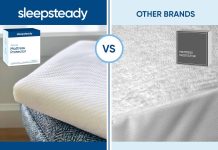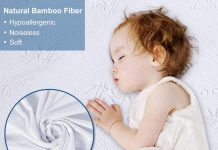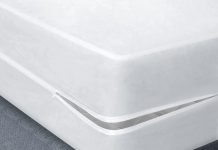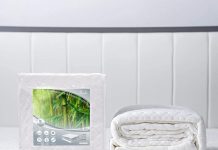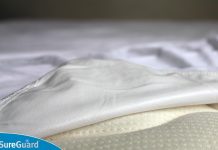Looking for the best way to dry a mattress protector? We’ve got you covered! No pun intended. Whether you spilled a cup of coffee or your little one had an accident, drying a mattress protector properly is crucial to maintaining its integrity and prolonging its lifespan. In this article, we’ll share some effective techniques and tips on how to ensure your mattress protector is thoroughly dried without compromising its quality. Say goodbye to dampness and hello to a fresh and clean mattress protector!
Review contents
Air Drying Method
Outdoor Drying
One of the most common and traditional methods of drying a mattress protector is by air drying it outdoors. This method allows for natural ventilation and sunlight to help in the drying process. To air dry your mattress protector outdoors, simply hang it up on a clothesline or lay it flat on a clean surface, making sure it is exposed to direct sunlight. The sunlight not only helps in drying the protector but also acts as a natural disinfectant, eliminating any potential bacteria or odor.
Indoor Drying
If outdoor drying is not a viable option due to weather conditions or lack of outdoor space, indoor drying is another effective method. To air dry your mattress protector indoors, place it on a drying rack or hang it over a shower rod. Ensure that there is sufficient air circulation in the room by opening windows or using fans to expedite the drying process. It is important to choose a well-ventilated area to prevent mold or mildew formation. With proper airflow and time, your mattress protector will dry completely.
Machine Drying Method
Tumble Dry Low Heat
For a quicker and more convenient option, machine drying using the tumble dry low heat setting can be effective. Simply place your mattress protector in the dryer and select the lowest heat setting available. This gentle heat allows for the moisture to evaporate without damaging the fabric or the waterproof properties of the protector. It is important to check the manufacturer’s instructions to ensure that the protector is safe for machine drying. Once dry, remove the protector from the dryer promptly to prevent wrinkles from setting in.
Tumble Dry No Heat
If your mattress protector has specific care instructions that advise against using heat, the tumble dry no heat option is a suitable alternative. This setting relies solely on the tumbling action of the dryer to remove moisture. It may take longer than the low heat setting, but it is a safer choice for delicate materials, such as certain types of waterproof protectors. Always refer to the care label or contact the manufacturer for their recommended drying method to ensure the longevity of your mattress protector.
Sun Drying Method
Precautions
While sun drying can be an effective method, there are some precautions to keep in mind. Direct exposure to sunlight for prolonged periods may cause certain fabrics to fade or become brittle. It is important to check the care label or manufacturer’s instructions to ensure that sun drying is suitable for your mattress protector. Additionally, be cautious of leaving the protector outside for too long, as exposure to dew or rain can prolong the drying process and potentially lead to mildew growth.
Benefits
On the other hand, sun drying offers various benefits. The natural sunlight acts as a powerful disinfectant, killing any bacteria or germs that may be present on the mattress protector. It also helps remove any lingering odors, leaving your protector fresh and clean. Additionally, the sun’s rays can help restore the fabric’s natural softness and elasticity. Sun drying is an environmentally friendly method that requires no additional energy consumption, making it a cost-effective and sustainable option for drying your mattress protector.
Drying Duration
Factors Affecting Drying Time
The duration of drying a mattress protector may vary depending on several factors. The thickness and fabric composition of the protector play a significant role in how quickly it dries. Generally, thicker protectors or those made of materials with lower absorbency, such as polyester, may take longer to dry. Humidity levels and temperature in the drying environment also impact the drying time. Higher humidity levels and cooler temperatures will increase drying time, while lower humidity and warmer temperatures will expedite the process.
Recommended Drying Time
While the exact drying time for a mattress protector will depend on the aforementioned factors, it is generally advised to allow at least 24 hours for thorough drying. This timeframe ensures that the protector is completely dry, both on the surface and within the fabric layers. It is important not to rush the drying process, as partially dried protectors can retain moisture and become a breeding ground for mold or mildew. Patience is key to maintaining the integrity and longevity of your mattress protector.
Drying Frequency
Routine Drying
To maintain a clean and hygienic mattress protector, regular drying is recommended. After washing your protector, it is important to dry it completely before placing it back on the mattress. This routine drying not only helps eliminate any remaining moisture but also prevents the accumulation of dust mites or allergens. Ideally, aim to wash and dry your mattress protector every 1 to 2 months, or as per the manufacturer’s recommendations, to ensure optimal performance and extend its lifespan.
Emergency Drying
In certain situations where immediate use of the mattress protector is needed, emergency drying methods can be employed. When time is limited, opt for methods like machine drying on low heat or using fans to expedite the drying process. It is important to note that emergency drying should not substitute routine drying, as it may compromise the overall effectiveness and durability of the protector.
Pre-Drying Preparation
Spot Cleaning
Before drying your mattress protector, it is advisable to pre-treat any stains or spills to ensure a thorough clean. Spot cleaning involves gently scrubbing the affected areas using a mild detergent or stain remover and a soft cloth or sponge. Avoid using harsh chemicals or abrasive materials, as they may damage the fabric or compromise the waterproof properties. Once the stains are treated, proceed with the drying method of your choice.
Squeezing Out Excess Moisture
To expedite the drying process, it is beneficial to gently squeeze out excess moisture from the mattress protector after washing. Be careful not to twist or wring the protector, as this may damage the fabric or alter its shape. Instead, apply gentle pressure with your hands or place the protector between clean towels and press down to absorb excess water. Removing as much moisture as possible before drying reduces the overall drying time and ensures optimal results.
Drying Tips
Use of Fans or Air Blowers
To promote faster drying, consider using fans or air blowers in conjunction with your chosen drying method. Positioning a fan or air blower near the drying area helps increase airflow and facilitates moisture evaporation. This is particularly useful for indoor drying or on days when outdoor drying is not possible. Remember to adjust the fan’s speed or blower’s strength to a moderate level to avoid excessive disturbance or potential damage to the mattress protector.
Avoiding Direct Heat Sources
While some drying methods involve heat, it is important to avoid exposing the mattress protector to direct heat sources, such as radiators or hairdryers. Excessive heat can cause the fabric to shrink or melt, compromising the protector’s functionality and appearance. Instead, aim for controlled heat options, such as low heat in the dryer or indirect sunlight, to ensure the drying process is safe and effective.
Steam Cleaning Option
Benefits of Steam Cleaning
Steam cleaning is an effective alternative to traditional washing and drying methods for mattress protectors. The high temperature of the steam helps kill bacteria, dust mites, and other allergens without the use of chemicals. Steam cleaning also penetrates deep into the fabric, removing embedded dirt and stains, while simultaneously freshening and deodorizing the protector. This method is particularly beneficial for thicker or quilted protectors that may be challenging to wash and dry conventionally.
Precautions for Steam Cleaning
While steam cleaning offers numerous benefits, it is essential to exercise caution and follow proper guidelines when using this method. Ensure that your mattress protector is steam-friendly by checking the care label or contacting the manufacturer. Avoid excessive steam application, as it may saturate the fabric and prolong the drying process. Allow sufficient drying time after steam cleaning to ensure the protector is completely dry before placing it back on your mattress.
Special Care for Waterproof Protectors
Waterproof Protector Features
Waterproof mattress protectors typically require special care to maintain their functionality and longevity. These protectors are designed to repel liquid and prevent it from penetrating the surface. When drying waterproof protectors, it is important to ensure their impermeable barrier remains intact. Avoid using excessive heat or harsh chemicals, as they may compromise the waterproofing properties. Opt for gentle drying methods that preserve the protector’s waterproof feature.
Recommended Drying Methods
For waterproof mattress protectors, air drying is often the most recommended method. It allows the protector to dry thoroughly without subjecting it to excessive heat or potential damage from machine drying. If machine drying is necessary, choose the lowest heat setting available and ensure the protector is completely dry before removing it from the dryer. Following the manufacturer’s guidelines helps ensure the waterproof feature remains effective and the protector retains its protective qualities.
Recommended Drying Method Based on Material
Cotton Protectors
Cotton mattress protectors are known for their breathability and absorbency, making them comfortable and ideal for warm climates or individuals prone to sweating. When drying cotton protectors, air drying is the most recommended method. Hang them outdoors or place them on a drying rack with ample air circulation to allow for efficient moisture evaporation. Avoid direct sunlight for extended periods, as it may lead to fabric discoloration or stiffness. If machine drying is necessary, opt for low heat and remove the protector while slightly damp to prevent over-drying.
Polyester Protectors
Polyester mattress protectors are known for their durability and quick-drying properties. When drying polyester protectors, machine drying on low heat is the most suitable method. The low heat setting helps prevent shrinkage or damage to the fabric, while the gentle tumbling action of the dryer facilitates moisture evaporation. It is crucial to remove the protector from the dryer promptly once dry to minimize the chance of wrinkles or creases setting in.
Bamboo Protectors
Bamboo mattress protectors provide natural breathability, moisture-wicking capabilities, and antibacterial properties. When drying bamboo protectors, air drying is the preferred method. The open air and sunlight help preserve the natural properties of the bamboo fabric and ensure thorough drying. However, excessive exposure to direct sunlight may cause fading, so it is essential to monitor the protector’s drying progress. If machine drying is the only option, use the lowest heat setting and remove the protector while slightly damp to maintain its softness and integrity.





